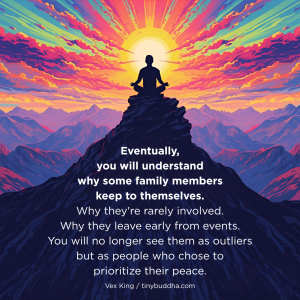
“Boundaries are a part of self-care. They are healthy, normal, and necessary.” ~Doreen Virtue
I still have the journal entry that sparked my journey into boundary setting. It says, in striking black pen, “I wish I could speak my truth. If I can learn to speak my truth before I die, I will die a happy woman.”
Dramatic? Maybe. But I was tired of being a pushover, a people-pleaser.
I’d written it the day after I’d been the recipient of unwanted advances at a bar. For thirty minutes, a stranger had engaged me in aggressive conversation, peppered in flirtation, and slipped his bony hand around my waist. I’d tolerated his behavior with a fake smile before escaping to the bathroom.
As often used to happen, I couldn’t speak up for myself. I’d waited in silence, hoping the man would mind-read my discomfort and give me space. The next morning, I took my pen and articulated what I saw as my Great Frontier in life: setting boundaries, communicating authentically, and heeding the needs of my inner self.
This challenge presented in all areas of my life. My tendency to people-please led to a sense of imbalance in relationships with friends, lovers, and colleagues. Sometimes, it manifested as mildly as staying too long in a conversation that bored me, or offering to help a friend when I didn’t have the time. Sometimes it was as extreme as sleeping with someone I didn’t want to sleep with because I didn’t want to “hurt his feelings.”
I was constantly betraying myself, constantly designing my life around others’ desires. The result was a life that felt mediocre, underwhelming, and not quite my own.
From an early age, women are taught to be people-pleasing, accommodating, and self-sacrificial. Over time, we can lose our connection to our authentic, empowered selves beneath the weight of our commitments, our imbalanced relationships, and our carefully constructed personas.
Everything changed when I went through a challenging breakup and awoke to the reality that I’d always been the sole person responsible for my own happiness.
I realized that this was my chance to develop a nurturing, supportive relationship with my inner self: the woman beneath the performing and the people-pleasing. For the first time, I made a commitment to become my own first priority, set firm boundaries, and communicate authentically with others. The rest is history.
If you leave conflicts wishing you’d spoken up for yourself; if you feel drained in social situations because you feel like you’re performing; if you over-commit to obligations and under-commit to activities that bring you joy; if you agree to be intimate with people, but later regret your decision; if you feel like you give much more than you receive in your relationships: this can be the year you break the pattern and begin speaking—and living—your truth.
Here are nine tips that break down the boundary-setting journey into simple, actionable habits.
1. Name your feelings in interactions with others.
Challenging emotions like overwhelm, anger, and frustration can be helpful guideposts as you uncover when, where, and with whom to set boundaries. These emotions signal that others might be impinging on your personal time or space. Developing literacy with your own emotions enables you to set impactful boundaries in the future.
Instead of pushing the feelings away, ask yourself, “What am I feeling? Why am I feeling this way? What would need to change for me to feel safer?”
2. Prepare your well-being disclaimer.
Preface conversations about boundaries with a disclaimer to set the stage for a compassionate, permissive discussion. (This can be a particularly useful tool if you’re concerned about rocking the boat by changing entrenched patterns in existing long-term relationships with family or lovers).
Break the ice by sharing your resolution to set boundaries. Explain why it’s important to you and how you believe it will benefit you. Centering your own well-being sparks a meaningful exchange around an indisputable value: your own wellness and health.
3. Express gratitude when others set boundaries.
Folks who have trouble setting boundaries usually have trouble responding to boundaries set by others.
Before I began setting my own boundaries, I often felt dismissed, angry, or rejected when friends or lovers put limits on our interactions. As I began to understand that people set boundaries to protect their own well-being, I intentionally cultivated an attitude of gratitude by responding to others with “I value your honesty” or “I appreciate you sharing that with me”—even if the boundary was hard to hear.
These friends and lovers became my role models and helped me envision what a healthily boundaried life could look like.
4. Practice saying “no thanks” without giving a reason.
It’s common to feel like you need to explain your boundaries to others. But you don’t—and sometimes the simplest, most honest response is “No, thanks.” (Giving an excuse or falsifying your reasoning can ultimately leave you feeling guilty or out of alignment with your inner self.)
Practice saying “No, thanks” and nothing more. Start small; say “No, thanks” when your housemate asks if you want to watch a TV show, or “No, thanks” to the person who wants to buy you a drink at the bar.
5. Craft a VIP-Only list.
Without a clear sense of your own boundaries, you may regularly overshare personal information. Though truth-telling is a powerful exercise, sharing too much too quickly can make others feel uneasy, and may leave you feeling uncomfortably overexposed.
If you have a history of TMI, create a VIP-Only list: a list of sensitive topics that you will only discuss with trusted people who make you feel safe and seen. Using this list as a guideline will help you develop a sense of self-trust as you maintain your privacy and build a community of dependable confidants.
6. Take a break from a toxic friendship.
Perhaps you have a friend who constantly uses you as a sounding board for his or her dilemmas, or asks for favors but never gives in return. Perhaps you have a friend whose personal struggles impose on your own sense of well-being.
One of the most difficult, yet most rewarding forms of boundary setting is to take a break from the relationships that no longer serve you.
If you have a one-sided friendship that leaves you feeling unseen, unheard, or disrespected, resolve to take a break from that relationship. And remember: It is not selfish or cruel to put your own well-being first. Healthy friendships are reciprocal and mutually nourishing, not one-sided and depleting.
7. Create a post-boundary-setting mantra.
If you have a history of people-pleasing, setting boundaries will be a major adjustment to old patterns, complete with the requisite growing pains. As such, it’s totally normal to feel guilty, selfish, or embarrassed after setting a (completely valid) boundary.
Be gentle with yourself and acknowledge that your boundary-setting muscle takes time to develop. In the meantime, prepare a mantra to refer to after setting difficult boundaries with others. It can be as simple as: “I set boundaries to feel safe,” or “Setting boundaries is an act of self-love.”
Your mantra can be your anchor, a permanent reminder that this journey, though difficult, has your best interests at heart.
8. Designate a cheerleader.
Throughout my boundary-setting process, I benefitted immensely by sharing my successes with a best friend who cheered me on at every turn. She bore witness to my journey and helped me acknowledge my progress when I was feeling self-critical.
Set yourself up for success by designating a cherished friend, family member, or partner to be your boundary cheerleader. Explain your intention to set better boundaries and your desire for a supportive buddy throughout the process. When you set a new boundary, let your cheerleader know, and carve out the space—in person, over the phone, or with a high-five emoji—for the two of you to celebrate your success.
9. Imagine how your life will be different.
Instead of focusing on oversharing and people-pleasing less, imagine the many ways you will benefit from setting boundaries. Gently allow yourself to imagine how your life will be different when you begin to speak your truth. How will you change? How will your daily life become richer? How might you feel more authentic in your relationships? Keep your vision at the forefront as you make the decisions that are best for you, day by day.
—
Boundaries are tools that enable us to feel safe, strong, and empowered in our relationships. As your journey progresses, you’ll begin to feel more empowered by the truth that it’s not only your right, but your duty, to make the choices that are best for you.
About Hailey Magee
Hailey Magee is a Codependency Recovery Coach who helps individuals conquer people-pleasing, set empowered boundaries, and master the art of speaking their truth. She has worked with over 100 clients from the US, Canada, Ireland, France, South Africa, and more. Sign up for a complimentary consultation to learn how coaching can help you live from a place of authenticity and inner freedom. You can follow Hailey on Facebook and Instagram, or visit www.haileymagee.com.
- Web |
- More Posts













 Though I run this site, it is not mine. It's ours. It's not about me. It's about us. Your stories and your wisdom are just as meaningful as mine.
Though I run this site, it is not mine. It's ours. It's not about me. It's about us. Your stories and your wisdom are just as meaningful as mine.